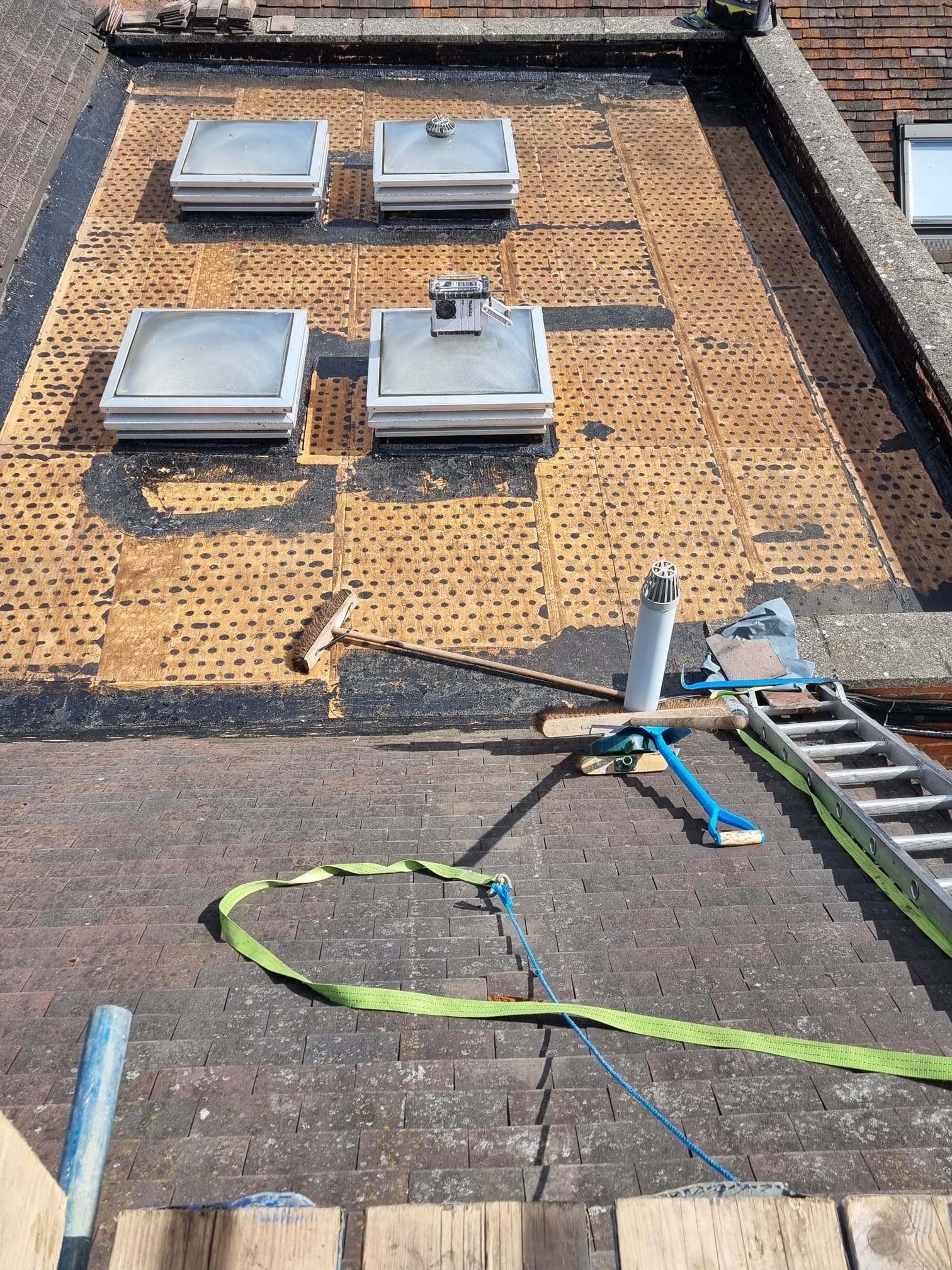+44 7853 968135
What’s the best flat roof covering?
Selecting the right flat roof covering represents one of the most critical decisions property owners face when building or renovating. The choice directly impacts durability, maintenance costs, and long-term property value, making it essential to understand the various options available in today’s market.
Modern flat roof coverings have evolved significantly, offering solutions that balance performance, cost-effectiveness, and longevity. From traditional felt systems to cutting-edge synthetic membranes, each material brings distinct advantages suited to different requirements and budgets.
What is the Best Type of Flat Roof Covering?
EPDM (Ethylene Propylene Diene Monomer) rubber membrane consistently ranks as the superior flat roof covering for most residential and commercial applications. This synthetic rubber material offers exceptional durability, weather resistance, and flexibility across temperature variations, making it suitable for the UK’s challenging climate conditions.
The membrane’s seamless installation creates a watertight barrier that remains flexible in both freezing winters and hot summers. EPDM systems typically last 25-30 years with minimal maintenance, providing excellent value despite higher initial costs compared to traditional alternatives.
GRP (Glass Reinforced Plastic) fibreglass represents another premium option, particularly favoured for its seamless finish and exceptional longevity. This liquid-applied system creates a completely waterproof surface with no joints or seams, eliminating common failure points found in other roofing materials.
Professional installation ensures optimal performance, with properly installed GRP systems often exceeding 30-year lifespans. The material’s resistance to UV degradation and thermal movement makes it particularly suitable for areas experiencing extreme weather conditions.
Need some Support with Flat Roofing? Speak with a member of our Professional Flat Roofing Team here

What is the Longest Lasting Flat Roofing Material?
Modified bitumen systems, particularly those incorporating advanced polymer technologies, offer the longest service life among flat roofing materials. These multi-layer systems can achieve lifespans exceeding 30-40 years when properly installed and maintained, making them exceptional long-term investments.
The durability stems from multiple protective layers working together to resist weathering, thermal stress, and physical damage. High-quality modified bitumen incorporates polymer modifiers that enhance flexibility and crack resistance, crucial factors in extending roof life.
Single-ply TPO (Thermoplastic Polyolefin) membranes also demonstrate remarkable longevity, with many installations approaching 25-30 year lifespans. The material’s heat-weldable seams create permanent bonds stronger than the membrane itself, eliminating common failure points associated with adhesive-based systems.
| Material | Expected Lifespan | Key Longevity Factors |
|---|---|---|
| Modified Bitumen | 30-40 years | Multi-layer protection, polymer enhancement |
| EPDM Rubber | 25-30 years | Flexibility, UV resistance |
| GRP Fibreglass | 25-35 years | Seamless application, chemical resistance |
| TPO Membrane | 20-30 years | Heat-welded seams, reflective properties |
What is the Cheapest Option for a Flat Roof?
Built-up roofing (BUR) using traditional felt layers remains the most economical flat roof covering option for budget-conscious property owners. This time-tested system involves multiple layers of roofing felt bonded with hot bitumen, creating a durable barrier at a fraction of premium membrane costs.
The material costs for BUR systems typically represent 40-60% less than modern single-ply alternatives, making them attractive for large commercial projects or residential applications with tight budgets. However, the labour-intensive installation process can offset some material savings, particularly for smaller projects.
Three-layer felt systems provide adequate protection for most applications, with mineral surface treatments offering additional UV protection and fire resistance. While not matching the longevity of premium systems, properly installed felt roofs can provide 15-20 years of reliable service with appropriate maintenance.
The UK government’s Building Regulations require flat roofs to meet specific performance standards regardless of material choice, ensuring even budget options provide adequate weather protection when properly specified and installed.
What is the Cheapest Way to Cover a Flat Roof?
Liquid waterproofing systems represent the most cost-effective approach for covering existing flat roofs, particularly when applied as maintenance coatings over structurally sound substrates. These systems eliminate the need for complete roof replacement, reducing both material and labour costs significantly.
Acrylic and polyurethane liquid coatings can extend roof life by 10-15 years at a fraction of replacement costs. The application process requires minimal disruption to building occupants, making it ideal for occupied commercial properties or residential buildings where access limitations exist.
Cold-applied liquid systems offer particular value for DIY-capable property owners, though professional application ensures optimal performance and warranty coverage. The seamless finish eliminates joints and mechanical fixings that commonly fail in traditional roofing systems.
| Covering Method | Typical Cost Range | Best Applications |
|---|---|---|
| Liquid Coating | £8-15 per m² | Existing roof maintenance |
| Three-Layer Felt | £25-40 per m² | New construction, budget projects |
| EPDM Membrane | £45-70 per m² | Long-term value, premium projects |
| GRP Fibreglass | £50-80 per m² | Seamless finish requirements |
For comprehensive guidance on building regulations compliance, property owners should consult the UK Government’s Planning Portal which provides detailed information about flat roof construction standards.
Additionally, the HSE’s guidance on roof work safety offers essential information for anyone considering flat roof installation or maintenance work.
Selecting the Optimal Flat Roof Covering Solution
Choosing the best flat roof covering requires balancing immediate budget constraints against long-term performance expectations and maintenance requirements. Property owners must consider factors including building use, local climate conditions, and planned occupancy duration when evaluating options.
Professional consultation ensures material selection aligns with specific project requirements and local building regulations. Experienced contractors can assess structural capabilities, identify potential complications, and recommend systems that optimise performance within available budgets.
The most cost-effective approach often involves investing in quality materials and professional installation rather than selecting the cheapest immediate option. This strategy minimises long-term maintenance costs, reduces replacement frequency, and maintains property values over time.
Key considerations for optimal flat roof covering selection:
Need Help with Flat Roofing Matters? Talk to one of our Flat Roofing Experts today!
What’s the Best Flat Roof Covering: Frequently Asked Questions
Consider your budget, expected roof lifespan, local climate conditions, building regulations compliance, and maintenance requirements. Professional assessment of your existing roof structure and drainage systems will help determine the most suitable material for your specific situation.
EPDM rubber roofing typically lasts 25-30 years with minimal maintenance, whilst traditional three-layer felt systems generally provide 15-20 years of service. The longer lifespan and reduced maintenance requirements often justify EPDM’s higher initial cost through improved lifecycle value.
Whilst some liquid coating systems allow DIY application, most flat roof coverings require professional installation to ensure proper weatherproofing and warranty compliance. Professional installation also ensures adherence to building regulations and health and safety requirements.
Cold-applied systems use adhesives or mechanical fixings without requiring heat during installation, making them safer and more suitable for occupied buildings. Hot-applied systems, such as traditional built-up roofing, use heated bitumen but may offer superior adhesion and longer-term performance.
Professional inspection can determine structural integrity, insulation condition, and substrate suitability for overlay systems. Generally, roofs with significant structural damage, inadequate insulation, or multiple previous repairs require complete replacement rather than overlay solutions.
EPDM and GRP systems require annual inspections and occasional cleaning, whilst felt systems may need more frequent attention to seams and flashings. All flat roofs benefit from regular debris removal and drainage system maintenance regardless of covering material.
Modern materials like EPDM and TPO offer recyclability benefits, whilst some systems incorporate recycled content. Consider thermal performance for energy efficiency and reflective properties that can reduce cooling costs in commercial applications.
UK climate conditions including freeze-thaw cycles, UV exposure, and heavy rainfall require materials with excellent flexibility and weather resistance. Systems must accommodate thermal movement whilst maintaining watertight integrity throughout seasonal temperature variations.
UK Building Regulations Part L requires adequate thermal performance, whilst Part C addresses weather resistance and drainage. Local authorities may have additional requirements, and professional consultation ensures full compliance with applicable standards and planning permissions.
Liquid coatings add minimal weight (typically 1-3 kg/m²), whilst built-up systems can add 15-25 kg/m². Structural engineers should assess load-bearing capacity before specifying heavier systems, particularly for older buildings or extensive roof areas.
Material warranties typically range from 10-25 years depending on system type, whilst installation warranties generally cover 10-20 years. Comprehensive warranties should cover both material defects and workmanship issues, with clear terms regarding maintenance requirements.
Most modern systems can be installed year-round with proper precautions, though some materials perform better in specific temperature ranges. Weather conditions affect cure times and installation procedures, making professional timing recommendations essential for optimal results.
Modified bitumen or TPO systems often provide the best value for large commercial applications, offering durability and performance at reasonable square-metre costs. The scale of large projects can justify premium materials through reduced per-unit installation costs and improved lifecycle economics.
The Wikipedia page on flat roofing provides comprehensive technical information about construction methods and material properties. For official guidance, consult the UK Government’s Building Standards which detail current requirements for roof construction and performance standards.

